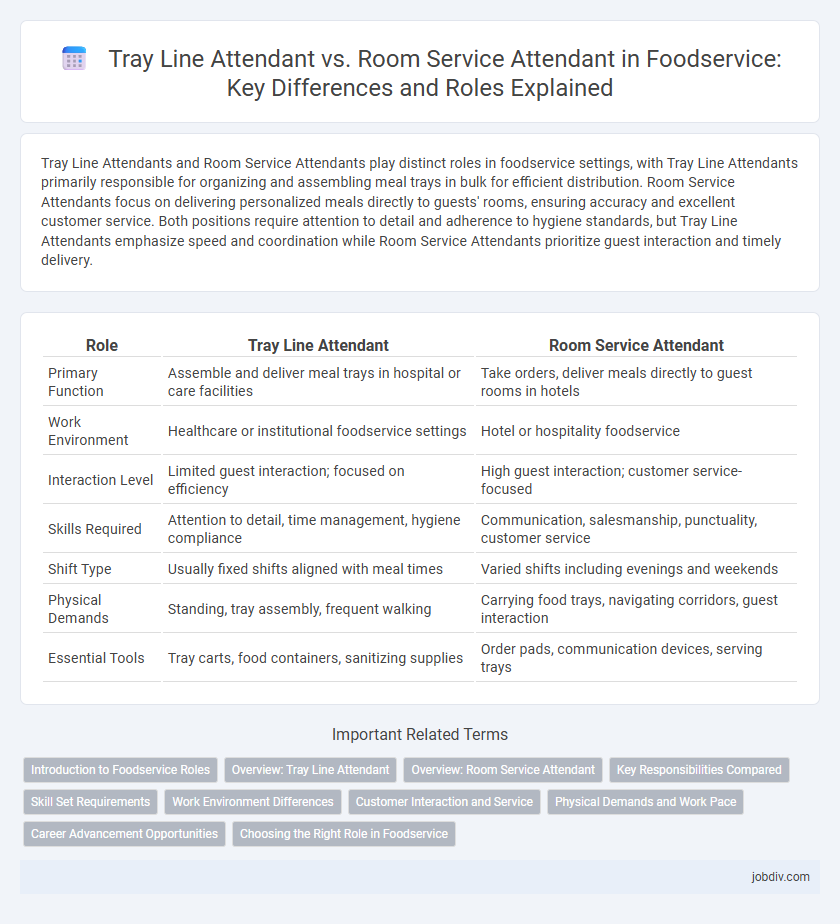Tray Line Attendants and Room Service Attendants play distinct roles in foodservice settings, with Tray Line Attendants primarily responsible for organizing and assembling meal trays in bulk for efficient distribution. Room Service Attendants focus on delivering personalized meals directly to guests' rooms, ensuring accuracy and excellent customer service. Both positions require attention to detail and adherence to hygiene standards, but Tray Line Attendants emphasize speed and coordination while Room Service Attendants prioritize guest interaction and timely delivery.
Table of Comparison
| Role | Tray Line Attendant | Room Service Attendant |
|---|---|---|
| Primary Function | Assemble and deliver meal trays in hospital or care facilities | Take orders, deliver meals directly to guest rooms in hotels |
| Work Environment | Healthcare or institutional foodservice settings | Hotel or hospitality foodservice |
| Interaction Level | Limited guest interaction; focused on efficiency | High guest interaction; customer service-focused |
| Skills Required | Attention to detail, time management, hygiene compliance | Communication, salesmanship, punctuality, customer service |
| Shift Type | Usually fixed shifts aligned with meal times | Varied shifts including evenings and weekends |
| Physical Demands | Standing, tray assembly, frequent walking | Carrying food trays, navigating corridors, guest interaction |
| Essential Tools | Tray carts, food containers, sanitizing supplies | Order pads, communication devices, serving trays |
Introduction to Foodservice Roles
Tray Line Attendants efficiently assemble and deliver meal trays in institutional foodservice settings, ensuring accuracy and timely distribution to enhance customer satisfaction. Room Service Attendants focus on personalized meal delivery within hotels or healthcare facilities, providing tailored guest interactions and handling special requests. Both roles are crucial in maintaining service quality and operational flow in various foodservice environments.
Overview: Tray Line Attendant
Tray Line Attendants play a crucial role in foodservice operations by efficiently assembling and organizing meal trays according to dietary requirements and menu specifications. They ensure timely delivery readiness by coordinating with kitchen staff and maintaining proper food presentation standards. Their responsibilities include verifying meal components, replenishing supplies, and adhering to hygiene protocols to support a seamless food distribution process.
Overview: Room Service Attendant
Room Service Attendants specialize in delivering food and beverages directly to guest rooms, ensuring timely and accurate order fulfillment tailored to individual preferences. They maintain impeccable presentation and hygiene standards while coordinating with kitchen staff to manage order flow efficiently. Expertise in guest interaction, menu knowledge, and handling specific dietary requests distinguishes Room Service Attendants within the foodservice industry.
Key Responsibilities Compared
Tray Line Attendants focus primarily on assembling and delivering meal trays efficiently in high-volume foodservice environments, ensuring accuracy and timeliness in each order. Room Service Attendants handle direct guest interaction by taking orders, delivering food to rooms, and addressing immediate guest needs to ensure a personalized dining experience. The key responsibility difference lies in the Tray Line Attendant's emphasis on batch processing and logistical coordination versus the Room Service Attendant's focus on customer service and order customization.
Skill Set Requirements
Tray Line Attendants require strong organizational skills and efficiency in handling high volumes of meal trays while maintaining hygiene standards in foodservice environments. Room Service Attendants need excellent communication abilities and personalized customer service skills to deliver food orders promptly and ensure guest satisfaction in hotel settings. Both roles demand attention to detail, time management, and knowledge of food safety protocols to meet operational standards.
Work Environment Differences
Tray Line Attendants primarily work in fast-paced, centralized kitchen or cafeteria settings, focusing on preparing and delivering multiple trays efficiently during peak meal times. Room Service Attendants operate in hotel or healthcare environments, providing personalized meal delivery directly to guest or patient rooms, often requiring interaction and tailored service. The Tray Line Attendant's work is highly repetitive and assembly-line oriented, while the Room Service Attendant's role demands flexibility, customer service skills, and adherence to specific delivery schedules.
Customer Interaction and Service
Tray Line Attendants primarily focus on efficiently delivering meals to guest rooms with minimal direct interaction, ensuring timely and accurate order execution. Room Service Attendants engage more personally with guests, often taking orders, answering questions, and providing a tailored dining experience that enhances customer satisfaction. The level of direct communication and personalized service distinguishes Room Service Attendants, fostering stronger guest rapport compared to the more task-oriented role of Tray Line Attendants.
Physical Demands and Work Pace
Tray Line Attendants endure repetitive lifting and steady pacing, managing multiple trays simultaneously in high-volume foodservice environments, which requires sustained physical stamina and agility. Room Service Attendants face varied physical demands, such as navigating different room layouts and carrying trays over longer distances, with a work pace that fluctuates between busy peak hours and slower periods. Both roles demand endurance but differ in the intensity and variability of movement, impacting physical workload and fatigue levels.
Career Advancement Opportunities
Tray Line Attendants gain valuable experience in high-volume food delivery systems, often advancing to supervisory roles such as Tray Line Supervisors or Foodservice Coordinators. Room Service Attendants develop personalized guest interaction skills that open pathways to positions in hospitality management, including Guest Services Manager or Room Service Supervisor. Career advancement in foodservice favors those leveraging operational efficiency and customer service expertise to move into leadership and specialized management roles.
Choosing the Right Role in Foodservice
Selecting the right role between Tray Line Attendant and Room Service Attendant depends on operational needs and customer interaction levels. Tray Line Attendants focus on efficient meal assembly and organization in high-volume settings, prioritizing speed and accuracy, while Room Service Attendants require strong customer service skills and attention to detail for personalized food delivery. Understanding the specific demands of each position ensures optimal staff performance and enhanced guest satisfaction in foodservice establishments.
Tray Line Attendant vs Room Service Attendant Infographic

 jobdiv.com
jobdiv.com